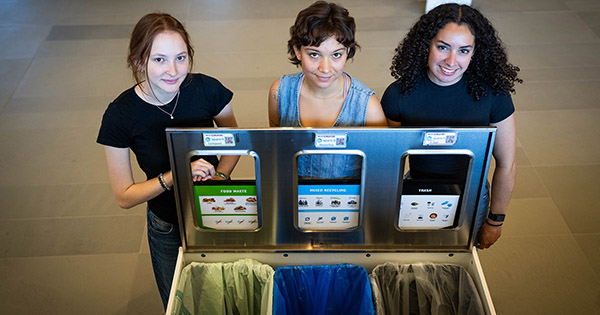When was the last time you took a picture of your trash?
Uhhh….
For Boston University Sustainability interns Tess Shotland (CAS’26), Nina Palmer (Questrom’25, CAS’25), and Cece Lagomarsino (CAS’24), photographing garbage is just part of the job.
Why? The three interns work at BU’s Center for Computing & Data Sciences, which is already one of the greenest buildings in New England. If all goes according to plan, the center, affectionately called the Jenga building, will add another important designation to its résumé.
“Everybody talks about the geothermal wells and the no fossil fuels, but we’re also striving to be a TRUE zero-waste–certified building,” says Sam Moller, BU Sustainability assistant director of communications. “That’s arguably harder than getting an LEED certification because zero waste is all about human behavior.”
TRUE zero-waste designation requires a facility to divert a baseline 90 percent of its waste away from landfills and incinerators and ensure that “contamination”—aka incorrectly disposed-of items—is under 10 percent. The 90 percent number comes from the fact that in general, about 90 percent of the waste we generate could be “recycled, composted, reduced, or eliminated altogether,” Moller says. (The TRUE designation requires a year’s worth of data before a facility can be certified.)
That means keeping items in the correct waste bins—mixed recycling, food waste, or trash—is priority number one.
And that’s where the interns come in. Each bin has a sensor that tracks the weight of its contents. But as for what those contents include? Cue Shotland, Palmer, and Lagomarsino. They make the rounds every shift with their phones, photographing bins throughout the building’s 17 floors to see what’s being put where and to see who needs a little lesson in proper disposal. (The photos and weight data go to Spare-It, a Boston-based waste technology company partnering with BU Sustainability.)
One of the biggest sources of confusion? Coffee cups.
A cold cup from Starbucks is one of the most common things the interns educate people about, Moller says. “They’ll stop someone and say, like, ‘Hey, did you know that you can dump out your ice in the compost bin? Then your straw goes in the trash, and you put the lid back on the cup, and that can go in recycling.”
Of course, CDS is one of the biggest buildings on BU’s campus. Thousands of people flow in and out daily, particularly to the common spaces on the first and fifth floors. Getting everyone on board is an almost herculean task—but one that Sustainability is more than up to.
“We’re already at about 70-ish percent diversion,” Moller says, thanks in part to the interns’ work, as well as “back of the house” efforts with BU’s Facilities and Catering. Cases in point: Catering on the Charles no longer serves box lunches in the building. And Saxby’s, the coffee shop on the first floor, has a diversion rate in the high 90s.
Okay, sure, it might be a little weird that people go around taking pictures of garbage. But the end result will be something that all of BU can be proud of.
Explore Related Topics:

Wanda Parisien is a computing expert who navigates the vast landscape of hardware and software. With a focus on computer technology, software development, and industry trends, Wanda delivers informative content, tutorials, and analyses to keep readers updated on the latest in the world of computing.


